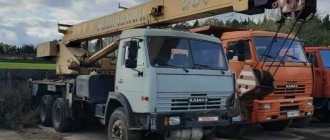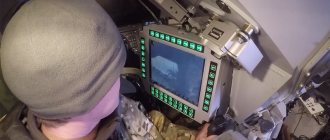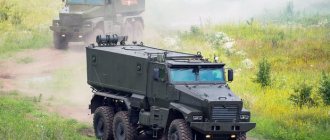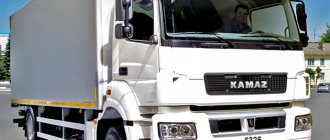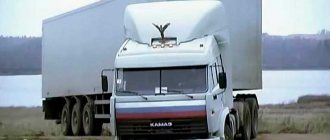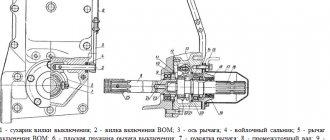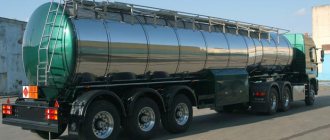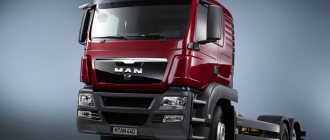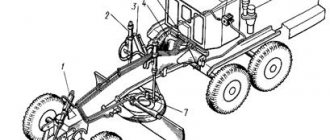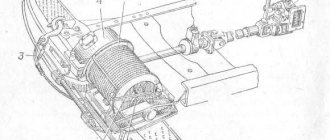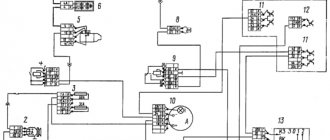Alexander Privalov, Yuri Petrov Photos by the authors and Alexander Eremtsov
At the MAKS-2015 air show, held in Zhukovsky from August 25 to 30, KAMAZ-53949, the smallest “typhoon” in the Typhoon-K family, could be seen in the open area. This car debuted a year ago at Interpolitex-2014. But now it was presented not as a protected vehicle, but as a reconnaissance vehicle.
The manufacturer of the final product, JSC NPO Strela from Tula, openly indicated on the advertising sign that this was an initiative development. The intrigue is that KAMAZ-53949 “Typhoon” at the time of the factory presentation in June 2013 was also the fruit of other people’s initiatives.
History of origin
At the end of the twentieth century, the USSR planned to create a unified chassis model for military vehicles. This project was part of the secret Garage program, which was terminated due to lack of funding and the collapse of the Soviet Union.
However, in 2010, as part of the strategic plan for the development of military equipment, the creation of such a vehicle platform for military armored vehicles became possible again.
The vehicles included in the Typhoon family, which include KamAZ-63968, KamAZ 63969, KamAZ 53949, Ural-63095 and Ural-63099, were first shown in mid-2011. Demonstration tests of these vehicles were carried out on the territory of the training ground of the Central Research Institute of the Ministry of Defense of the Russian Federation.
More than 120 Russian enterprises took part in the development of armored vehicles, including KamAZ, UralAZ, YaMZ, Rosatom (Federal Nuclear Center in Sarov), Moscow Steel Research Institute, Moscow State Technical University. Bauman and others.
Cars included in the Typhoon family
Vehicles of the Typhoon family were demonstrated at a military parade on May 9, 2014 and 2015.
The first batches of armored vehicles arrived at military units in the winter of 2014 and spring of 2015.
Fact. The division of the equipment into two batches was due to the need for improvements after the next tests.
Historical realism
They first started talking about protected Typhoon vehicles in the summer of 2011, when a semi-closed demonstration of this equipment took place to the then Minister of Defense of the Russian Federation Anatoly Serdyukov. In particular, prototypes of KAMAZ-63968, Ural-63099 and Ural-63095 were shown. The equipment was shown only briefly on TV, and the upcoming scope of modernization of the military equipment fleet could only be understood from specialized federal media (see “GP” No. 8, 2011).
The published data read: KAMAZ OJSC and Ural Automobile Plant are creating families of protected vehicles with 4x4, 6x6, 8x8 wheel arrangements. The background to their appearance is thorny and ornate.
Since the beginning of the 2000s, the topic of the global division of labor and Russia’s participation in it has been actively promoted. There was a reason for this, as HSE scientific director Evgeniy Yasin confirmed: “We cannot produce competitive products in all sectors of the economy. Something will have to be purchased externally.”
To this must be added the high costs of producing one unit of output. Since the 1960s, labor productivity in the mechanical engineering industry of the USSR, the Russian Federation and a number of CIS countries has rarely risen above 40% compared to the American or German levels.
That is why in 2008 a course was chosen to purchase military products abroad, including military vehicles and automotive components for them.
The automotive industry, in which the most important component is the production of auto components, was supposed to be transferred to import assembly. But the correctness of the chosen course was not obvious: after all, more than 95% of the ground mobile weapons and military equipment of the Russian Armed Forces are mounted on automobile base chassis.
The understanding that in the event of any friction with the EU, NATO and other blocs and alliances a systemic crisis is possible came later, when global politics began to interfere with Russia’s export interests: wars and coups d’etat in Libya, Egypt, Iran, Syria led to the loss of economic contracts and loss of profitable deals.
Design
Unified units
The unified Typhoon base consists of the following units:
- diesel engine;
- hydromechanical automatic transmission;
- independent controlled suspension;
- on-board information and control system (BIUS);
- adjustable pressure tires.
Functional
Models can be biaxial or triaxial.
The pressurized military transport body is pressurized. Air coming from outside first passes through the filters of the FVU-100 system.
The unified platform is intended for the installation of armored modules, cargo (open or closed) platforms or containers, as well as for modules for moving landing groups.
It is recommended to install vehicles for the following purposes:
- to provide fire support;
- for reconnaissance;
- for sanitary needs;
- command posts;
- transport and launch equipment for missiles;
- transportation of personnel;
- convoy.
On a note. Armored vehicles have a fairly high speed for such a mass - about 100 km/h.
Damage protection
The high level of ballistic and mine protection is due to the combined armor (steel and ceramics) and the presence of armored glass, which allows vehicles to be protected at 380 degrees. The V-shaped bottom, combined with seats that absorb explosive power, provides protection against mine explosions.
The roofs of the Typhoons are equipped with an emergency evacuation system for fighters - special hatches. Video cameras installed around the perimeter provide all-round surveillance. They also make it possible to control the armored vehicle if there is no visibility through the windshield.
For additional protection against rocket-propelled anti-tank grenades, hanging mats have been developed, which are recommended to be attached with belts or Velcro to the car body. This design disrupts the formation of a cumulative jet and significantly reduces the risk of damage to the body.
Interesting. During tests, a 6-kilogram projectile (the equivalent of TNT) was exploded under the bottom of the KamAZ-63968, and only the tires and a few body parts were damaged. The cabin and interior of the body remained completely intact.
Design features
For maximum protection of the armored vehicle, the power plant and some transmission elements are located in a protected module, which is located between the cargo body and the cabin. It is this, as well as the high requirements for crew protection, that influences the weight distribution along the axles. To properly distribute the load, the second pair of wheels on the Typhoons has been moved closer to the cabin.
The car has steered front axles and an independent hydropneumatic suspension, which allows you to change the ground clearance if necessary.
Armored vehicles KamAZ-53949, KamAZ-63968 and KamAZ-63969
Home » Real story » Little-known and unrealized projects of tanks and other armored vehicles » Armored vehicles KamAZ-53949, KamAZ-63968 and KamAZ-63969
Little-known and unrealized projects of tanks and other armored vehicles
byakin 01/20/2015 627
0
in Favoritesin Favoritesfrom Favorites 0
The LJ of the respected Denis Mokrushin published his interview (consisting of three parts) with the chief designer of KAMAZ OJSC for working with law enforcement agencies, Yu.A. Kukharenko. I think that the information from this interview will be of interest to colleagues.
Part one. KAMAZ-53949
— Yuri Alekseevich, tell our readers about your new armored vehicle KAMAZ-53949.
— A vehicle with a 4x4 wheel arrangement and a carrying capacity of 2 tons. The level of protection is the same as that of the main Typhoon-K family, i.e. provides protection against hits from armor-piercing incendiary bullets of 7.62 caliber from the SVD rifle in any projection. Mine protection – 6 kg of TNT under the wheel and any part of the car’s bottom. The main components and assemblies are unified with the family of 6x6 vehicles.
The wheels are smaller in size (by 1 step) compared to cars of the older family - 14.00 R20. The wheels are combat-resistant, tubeless, and allow driving with completely deflated tires for at least 50 km, at speeds up to 50 km/h.
The vehicle capacity is 10 people: driver, vehicle commander and 8 landing personnel.
The first prototype is currently undergoing preliminary factory tests (currently, run tests). Another car is being assembled at the plant. The first results of preliminary tests may appear in the middle of this year.
Security forces are very interested in cars of this type. Both the Airborne Forces, the Marine Corps, and the ground forces are showing great interest in it. Moreover, there are statements that such cars are even preferable to cars with a 6x6 wheel arrangement.
— What requirements do the military put forward for this vehicle?
— The main requirement for paratroopers is airborne capability. Along with airborne capability, the Marine Corps also requires buoyancy. The ground forces want the vehicle to be as simple as possible: spring suspension instead of hydropneumatic struts, less electronics, and the absence of an on-board information and control system (BIUS). We would like potential customers from different branches of the military to decide among themselves which requirements are the highest priority, after which we, the designers, could focus on the most important areas of improving the vehicle.
— Please clarify, do the Airborne Forces require airborne capability or air transportability?
— To a greater extent, airborne capability. Air transportability is already included in the TTZ. It is planned to transport the cars in Il-76, An-124 aircraft and the Mi-26 helicopter after the approval process is carried out in the established manner.
— Will the Marine Corps requirements for vehicle buoyancy lead to a decrease in the vehicle’s mine resistance?
“I think that if it becomes necessary to provide buoyancy, then we will most likely have to forget about mine resistance as it is now. At most, it may be possible to maintain mine resistance at the level of 2 kg of TNT under any point of the body by reducing the weight of the vehicle. If we receive demands, we will work in this direction.
— Is the Ministry of Internal Affairs interested in the car?
- Yes. But, as in the Ministry of Defense, they express wishes to make the car cheaper. Unfortunately, reducing the price will most likely lead to a decrease in the level of security. Now we have a limitation on the high cost of prototypes, but once the machine goes into production, I think the price will be acceptable for the Customer.
— Are imported components used in the production of the car?
— A pressing question in light of the sanctions applied to Russia today. Yes, at the moment, a lot of foreign components are used in the design of the car. But we have proposals to the Ministry of Defense and the Ministry of Industry and Trade of Russia to include in the Federal Target Program for the development of the defense industry subprograms for the localization of production of four key positions of the component base in our country. Today these programs have already been formed and the main executors have been identified. For example, there is confirmation from the Ministry of Industry and Trade that investments have been allocated for the development of tires with dimensions of 14.00 R20, 16.00 R20 and 600/75R27 for special vehicles.
— How long will it take to get results?
— The main executors are already promising results soon. Approximately in 2017-2018 they should enter mass production. They are confident that everything will work out; today there are real design solutions and results of preparation for the production of new types of products.
Part two. KAMAZ-63968. Tests
— There is information that you have already tested the KAMAZ-63968 modular vehicle.
In September 2014, we completed preliminary tests of the vehicle and tested this vehicle at the testing grounds at TsNIITOCHMASH and at the 3rd Central Research Institute of BT. For the first time in Russia, instead of pigs and “witness” screens, we put special Hybrid III dummies in a car being blown up. They fired along the perimeter, firing more than 200 shots from different distances and angles. Afterwards, they carried out explosions with various means of destruction in accordance with the requirements of the technical specifications and the program-methodology. There were no breakthroughs, dummies with 37 sensors (acceleration, displacement, pressure) showed loads in the region of 35-50% of the maximum permissible.
Based on the test results, it was concluded that the person in the car would not have received life-threatening injuries.
Hybrid III dummy in the car cabin
Detonations of a 152-mm high-explosive fragmentation projectile were also provided at a distance of 25 meters from the vehicle. It was this distance that was included in the requirements for machine protection. Then it was decided to reduce the distance to 10 m, then to 5 m, and finally, they decided to carry out an explosion at a distance of 2 m. They blew it up. The ceramics were crushed by fragments, but there was no penetration, and the readings of the sensors on the mannequins did not record an excess of the permissible load level. We, the designers, were very pleased to receive such a high result.
Before lateral detonation of 10 kg TNT
After lateral detonation of 10 kg TNT
After a side detonation of 10 kg TNT Video of a side detonation of 10 kg TNT
However, after taking all the readings from the sensors (on the seats, on the underbody, on the roof, on the steering wheel), we discovered some weak points that we are now working on. In some places we change the design in order to increase security, and in other places we may weaken the protection, because... it's redundant. Also, to optimize weight parameters, we will strive to reduce weight.
- By what standard did they fire and blow up: domestic or STANAG?
There was a so-called temporary methodology presented by the Russian Ministry of Defense. In addition, we assessed according to the STANAG standard.
— Tell us more about this technique.
“Previously, the agreed amount of ammunition was fired at the equipment from different angles, paying special attention to the places where the possibility of penetration is most likely. According to STANAG, structurally weakened zones are determined, where the designer himself determined the possibility of penetration.
Explosions were carried out under the front wheel on the driver's side, under the rear wheel, under the bottom in the middle of the troop compartment.
Well, the use of Hybrid III dummies made it possible to give a comprehensive assessment of what is happening inside the car to form a conclusion from specialists.
Filming inside the Typhoon armored car during explosion tests. In the role of the “soldier” is the Hybrid III dummy.
— What does the process of planting an explosive look like?
— A metal bowl with a cylindrical hole is buried flush with the ground, and water is spilled around the sand to compact it. 6 kg of trinitrotoluene is placed in the bowl. Then a car runs over it and an explosion occurs.
I believe that it is time to bring the domestic methodology for conducting such specific tests to a single standard. Otherwise, how can one say that this or that sample of our technology is superior or inferior to Western analogues if the tests were carried out in completely different ways?
— KAMAZ vehicles, when the conversation turns to resistance to explosions, are often criticized for their cabover design. They say that if a car hits a mine with its wheel, the entire force of the explosion will be taken by the cabin and the people in it. What did the tests of the modular Typhoon show when they exploded 6 kg under the front wheel on the driver’s side?
- Good question. Tests have shown that in the event of a possible explosion, both the driver and the senior vehicle remain alive, because the cabin design has a streamlined shape and dividers, which redirects the main energy of the explosion to the side. I also cannot help but note the rather successful layout of the power compartment: during testing, the explosion destroyed the wheel, but the driver was able to start the engine, and the car drove off. That is, neither the engine nor its systems were damaged.
Exploding 6 kg of TNT under a car
— Were these explosions part of state tests?
- No. These are preliminary tests, but the program was agreed upon with the Customer, represented by the Ministry of Defense. Military experts insisted that we should assign the letter “O” (works design documentation, adjusted based on the results of manufacturing and preliminary testing of prototypes) for working design documentation only after special tests. Therefore, we had to sacrifice two cars.
— Some kind of protection against RPGs was planned using special mats. What with her?
— Indeed, there are such hanging mats. And there are test results, although not ours. Tests were carried out by our partners.
— Will these mats be included in the Typhoon package?
— They will be attached additionally, in accordance with the requirements of the contract in the spare parts package. If the vehicle is sent to a combat area, it will be “pasted” with these elements, which will ensure its protection from grenade launcher shots.
— How are the mats attached to the vehicle’s armor?
- There are two options. The first one is with Velcro. Similar to those that we are used to seeing on clothes and shoes. Approximately the same device is used here, that is, these Velcro are glued with double-sided tape along the entire perimeter, in special sectors. Then mats are attached to them. Secondly, the mats are secured with special belts, allowing their quick installation and dismantling.
— How do these mats protect the car from the effects of a cumulative jet?
- Everything is actually simple, upon contact with the mat, a cumulative jet from the RPG is not formed, as it was intended. We must not forget about the possible installation of additional protection inside the module (anti-fragmentation coating).
— You said that these mats have not yet been tested in our country?
— No, we have not tested the mats yet, because the testing methodology did not include such a test. But when the turn comes for state tests, I think we will conduct such a test. We carried out tests on individual fragments of the mats, but abroad. Good results were shown. Now, in order not to shoot the entire sample, it is necessary to carry out the same tests on fragments of the protection in our country. And in a year we’ll try it on a finished car.
— There were samples of a vehicle with a remote weapons module. Will it be installed on every car? Or is it like some kind of option? What does the customer want?
— The customer, of course, wants to see it on every car. So that there is a weapons module, so that there is a radio station R-168. A remote controlled installation is very expensive, and so is the radio station. We are preparing installation sites for the installation of radio stations and modules, but today these products installed on cars are not specified in the contract. The contract stipulates that we must supply the vehicles with a certain configuration, although the terms of reference indicate that under a special agreement we must supply them with a radio station, remote installation, and weapons. In the future, as stated in the contract, we will deliver it.
According to DUMV. Today we have not yet tested these vehicles along with the installation of a remote weapon station. Previously, without firing, the effect of the DUMV stabilization device was tested in Kubinka, and good results were obtained. We did not conduct shooting in the vehicle, because they are not in the technical specifications, and these conditions were not included in the test program. We did it for ourselves and made sure that the installation was in good condition and was working properly. We plan to fire the prototype during state tests.
— Whose modules were used?
— Development module of JSC NPO Elektromashina (Chelyabinsk). In addition, proposals from Kalashnikov are being considered today.
— Are the seats in the Typhoon domestic?
— So far foreign, with elements of energy suppression of the impact of a mine explosion. They have their own know-how in this area, which they have not yet declassified. But, these seats will be localized in Russia, according to an already agreed upon program.
— That is, there will be no problems with imports?
- Exactly. The design is not simple, the most cunning device is the one that is compact and very cheap, but it just extinguishes this energy. Taking into account the fact that Russia has its own developments of similar seats, problems with imports can be avoided in the future.
— When will state tests of the modular Typhoon take place?
— State tests will begin in January and will last until September 2015. During this period, it is planned to conduct a full cycle of State tests and, if the test results are positive, to accept the vehicles for supply to the Russian Armed Forces. And in 2016, serial delivery of industrial batches is planned.
— What is the purpose of the Typhoon? Transportation of personnel?
“Today there are debates about this in the military department. For the transportation of personnel and their protection, of course. Like military reconnaissance vehicles, chemical reconnaissance vehicles, command and staff vehicles, ambulances, in the end. But we hear all this not from the military department, but from the developers. Today, developers from other Russian companies are coming to us who want to create special vehicles based on these machines. And we learn from them that it is planned to install a mortar launcher, Grad MLRS, minelayers, and so on on this vehicle (chassis).
— That is, work in this direction is already underway? Previously, KAMAZ announced a possible line of special equipment based on the Typhoon.
— This line, of course, was not taken out of thin air by us, but based on suggestions from our partners. We are still working on it on paper, but many would not refuse to purchase machines and make specialized equipment based on them. We hope that mass demand for these machines will begin after the completion of government tests.
— Automobile is also working on its own version of the Typhoon. Aren't you afraid that your competitors may be more successful?
— A competitor is always a competitor, so fears are natural. To compare both domestic and foreign samples, today there is a so-called “technical level indicator”, which is calculated using a special method, takes into account many factors, and is the most reliable. For example, the layout of our vehicles turned out to be very successful, in which the Typhoon 6x6 received non-standard two front steered drive axles. And this turned out to be the right decision of the chief designer, because the result was a balanced load on the axles. Because of this, the indicators of cross-country ability, maneuverability, controllability, and stability are much higher than if they had stayed with the old scheme: two axles at the rear, one steerable at the front. The front axle would sink all the time, the tires would wear out, and the steering would be heavier. This is only one indicator, but there are many more indicators that are embedded in electronic systems, on-board automated control and information systems that monitor and facilitate the driver’s work. These are ABS, automatic leveling systems, directional stability systems, a system for automatically turning off the suspension when a remotely controlled weapon module is operating, automatic locking systems for cross-wheel and center differentials, diagnostic systems, etc.
Armored vehicles "Typhoon" in the assembly shop
— What is the fate of the 30 modular Typhoons manufactured within the framework of the State Defense Order for military testing in the interests of the Ministry of Defense?
— At one time, we were unable to deliver the entire batch of cars to the customer for the following reasons. The Ministry of Defense additionally demanded special tests (ballistic, etc.), since only after these tests were the military ready to accept the entire batch of vehicles. We carried out tests this fall, after which we made some improvements to the vehicle protection elements. For example, the design of the engine compartment air intake grilles was redesigned because flammable liquid leaked through them during tests of resistance to napalm. The vehicles were transferred to the Ministry of Defense at the end of December 2014. By the way, some of them are planned to be used at the anniversary Victory Parade in 2015. We already prepared a driver’s force of military personnel for this in the spring of last year.
— How quickly can you master a car?
— Contract workers learned it quite easily. At first they were afraid, of course, afraid of pressing the wrong button, but they took on the learning process with enthusiasm. Instructors and test drivers were brought in. The servicemen liked the cars, they were literally crazy about them, they stayed late in the evenings and didn’t leave, not only to learn how to drive, but also to understand how to operate them, how everything worked. And I was pleased that the youth did not take into account the opinion of the commanders who say: “We don’t need such a complex machine in the troops yet, we would like a ZIS-5, ZIL-131, KAMAZ-4310. It’s still too early for us to have this “miracle technology”. Young people say: “I know that I will remain alive, that I will return home.” I'm glad that they perceive it correctly.
Part three. KAMAZ-63969
— How is work progressing on the KAMAZ-63969 box truck?
— It’s more difficult with a box car, because they haven’t found a niche for it yet. It is not yet recognized as a combat vehicle; such a level of protection for simple transportation of people is simply excessive.
— A box car has 14.5 all-round protection against bullets, if I’m not mistaken?
- Yes, 14.5 or 12.7. And protection against explosions of up to 8 kg of TNT under any part of the bottom. Although it passed the tests and lived up to its design ideas, today the military department is unclear where to use it. We will continue to test, but there is no certain clarity yet.
On trials—Are you doing it at your own expense?
- No, not at your own expense. At the expense of the Russian Ministry of Defense in accordance with the approved contract.
— But the Ministry of Defense itself does not yet know where to assign it?
- Yes. This problem still exists. But there are hopes that the place of “service” of this car will soon be determined.
— The current appearance of the hull Typhoon differs from the first prototype. In particular, a kind of glazed driver’s cabin appeared. What is this connected with?
— During the tests, it turned out that with such protection, a continuous panoramic windshield does not justify itself. Because it is heavy, it had to be additionally covered with an armored curtain. And this turned out to be quite difficult. The military and I agreed to replace this panorama with glass for the driver, and also installed side glazing to provide visibility. This is how the second option and prototype appeared.
— What kind of protection does this glazing have?
— Armored glass has been produced. The thickness of the glass is about a hundred and more millimeters. During testing, we shot at both the glass and the windshield frame with bullets, including 12.7 mm caliber. It passed the test.
— The prototype of the hull “Typhoon” had armor from the Steel Research Institute, without the use of ceramics. Have there been any changes to the armor of the prototype?
— No, we developed a prototype with our Russian partner. The prototype had spaced armor, without ceramics, with an air gap of about 70 millimeters between the sheets. We fired at fragments of this armor during testing and obtained high levels of ballistic resistance. But it made the car too heavy. The car weighed 24 tons when equipped. The result was zero load capacity. Then we were forced to switch to the version of two-layer armor with ceramics, but not spaced. First the substrate, sheet armor, and then thick ceramics. And this armor turned out to be 30% lighter, and in terms of ballistic resistance at the same level.
Possible appearance of a promising vehicle for the Marine Corps based on KAMAZ-63969
— If the Ministry of Defense never finds a use for a hull car, then what fate awaits it?
— If the hull Typhoon is not in demand, then the developments that we have gained today in creating this vehicle can be used in the interests of the Marine Corps, to create an amphibious armored personnel carrier. Instead of BTR-80, BTR-82, for example. If the military wishes, of course. In 2012-2013, Marines actively approached us with a request to create such a machine. But, for reasons unknown to us, work in this direction has been suspended for now. Possibly for financial reasons. Although today this work is relevant.
If we are nevertheless offered to create such an armored vehicle, we have a partner in St. Petersburg to implement such a project. So, it is possible to begin such work at any time on the basis of the created Typhoon hull.
sources:
- https://twower.livejournal.com/1545434.html
- https://twower.livejournal.com/1546573.html
- https://twower.livejournal.com/1550227.html
- https://youtu.be/0Mg5DuTs4lE
- https://youtu.be/BuiyFIjEaaM
- https://youtu.be/_xhioV5dM1
Surveillance and communications equipment
All equipment included in the family of armored unified vehicles is equipped with an on-board control system, internal and external video cameras, as well as a communication system between the body module and the cabin.
On-board system
The armored vehicles are equipped with the BIUS GALS-D1M system, which is designed for orientation, navigation and course indication. This device can operate both as part of an automated military control system and in autonomous mode. The control equipment makes it possible to optimize parameters and determine the most efficient mode of movement.
With the help of the BIUS, the location of the equipment, the required speed are calculated, the slope and roll of the road are calculated, as well as other important indicators.
GALS-D1M consists of the following elements:
- central control unit;
- monitor (display device);
- inertial navigation module;
- remote radar;
- satellite antenna.
BIUS capabilities
Calculation of the location of military equipment and its indication on an electronic map.
Navigation, route recording and saving.
Determining the distance to your destination and scaling.
Indication of the course and points/control points entered for display on the electronic map.
Search for coordinates and targets after entering their address.
Displaying the necessary movement parameters on the monitor, including determining the speed, coordinates, direction of movement, travel time to the point, etc.
Calculation of coordinates based on a known angle and range.
Storing electronic navigation maps in memory.
Diagnostics of components and systems indicating the fault code.
Modifications
KamAZ 63968 Typhoon K
A universal armored vehicle with increased protection. Unification with other members of the family is about 86%.
A modular design is used for production. To ensure protection, it is equipped with combined armor (ceramics, steel), which allows it to withstand the explosion of a high-explosive fragmentation device weighing eight kilograms (equivalent to TNT) and armored glass (thickness 128.5-129 mm). Level of protection against damage from bullets and shells is fourth.
The armored vehicle has a special embrasure for firing. It is possible to install a machine gun controlled by remote control.
The seat fastenings are located in the upper part of the module (on the roof), which significantly reduces the impact of explosions. The seats are equipped with special latches for personal weapons, headrests and belts that ensure safety while driving.
KamAZ 63968 Typhoon K
Air filtration is carried out by the FVUA-100A system. There is air conditioning on board the car.
At the stern of KamAZ 63968 there is a special platform (ramp) for landing. In case of a coup or the impossibility of fighters exiting through the door, emergency hatches were made in the upper part of the body.
Dimensions:
- width - 2550 mm;
- length - 7800 mm;
- cabin/fuselage height - 3120/3300 mm;
- weight - 21 tons.
KamAZ 63969 "Typhoon K"
Unlike the previous model, this armored vehicle is a body armored vehicle. The frontal parts of these models also have significant differences. KamAZ 63969 has two sheets of armor in the front part, which are installed at an angle to each other and armored glass with an adjustable shield.
KamAZ 63969 is similar to standard wheeled armored personnel carrier models. However, this vehicle is designed to transport soldiers and cargo and has a high degree of protection.
The body of the car has a multifaceted shape formed by armor connected at different angles. V-shaped bottom. Similar to the previous model, it reliably protects the Typhoon from blast waves.
There are emergency hatches above the driver's seat, as well as in the roof of the body, which allow you to get out of the car in case of an emergency. The ramp is equipped with a hydraulic lift and a door that can be opened manually. Between the wheel axles, on the side of the armored module, there is also an emergency exit.
Dimensions in millimeters:
- width - 2520;
- length - 8990;
- cabin height - 2750;
- weight - 23.7 tons.
KamAZ 63969 "Typhoon K"
KamAZ 53949 "Typhoon" 4×4
An armored vehicle with increased cross-country ability, provided by a 4x4 wheel arrangement. Combined armor - ceramics and steel. This machine widely uses the developments of previous models of the family.
Dimensions in millimeters:
- width - 2500;
- length - 6400;
- cabin height - 3300;
- weight - 15.7 tons.
KamAZ 53949 "Typhoon" 4×4
Ural 63095 "Typhoon U"
This equipment is produced at the Ural Automobile Plant and also belongs to the Typhoon family. It has a hood, frame, three-axle, all-wheel drive platform and a modular design. Combined armor (ceramics, steel). The body is equipped with two doors and emergency hatches.
Dimensions in millimeters:
- width - 2550;
- length - 8850;
- cabin height - 3500;
- weight - 24.5 tons.
Ural 63099 "Typhoon U"
A single-volume armored vehicle also created at the Ural Automobile Plant. Like all equipment of the Typhoon family, it has a high degree of protection provided by combined armor, shock-absorbing suspension that absorbs explosions, and a special bottom design. The body has three standard doors and three emergency hatches.
Dimensions in millimeters:
- width - 2550;
- length - 8400;
- cabin height - 3500;
- weight - 24.5 tons.
Ural 63099 "Typhoon U"
Projected upgrades
Development and further modification of military vehicles of the family continues. The latest known development may be an armored vehicle - "Typhoon - D" based on KamAZ-4386. This vehicle belongs to the class of hooded armored cars, equipped with two axles, and is intended for use in airborne troops.
The use of a load-bearing armored hull made it possible to reduce the weight of the armored vehicle by almost two tons compared to the previous model. It is planned to use a Cummins diesel engine as a power plant, as well as an automatic transmission with a drive on two axles.
Interesting. When testing the hull, a 152-mm shell was exploded 2 meters from it, the fragments of which did not damage the car.
